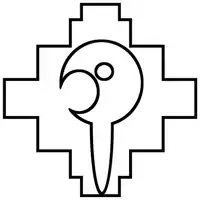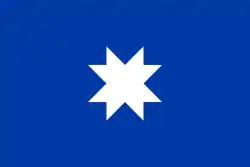Coordinadora Arauco-Malleco
Coordinadora Arauco-Malleco (CAM) is a radical[3] and militant indigenous organization engaged primarily in sabotage as a means to attain an autonomous Mapuche state in Wallmapu, which is, they say, the revindication and recovery of former Mapuche lands. CAM is known to use methods such as arson[5] and launch attacks against "Fuerzas Especiales" of Carabineros de Chile. It was founded in 1998, in Tranaquepe, Chile, and is responsible for land occupation in the zones of Tirúa, Contulmo, Cañete and Temucuicui. Protesters from Mapuche communities have used these tactics against multinational forestry corporations and private individuals backed by CAM paramilitary power as a form of exerting political pressure.[6]
| Coordinadora Arauco Malleco | |
|---|---|
 Emblem used by the Organos de Resistencia Territorial (military arm) in sabotage actions awarded by the CAM. The image represents a guemil (symbol of Mapuche iconography) with a Mapuche clava inside it. | |
| Leaders | Héctor Llaitul |
| Dates of operation | 1998–present |
| Active regions | La Araucania Region and Bio Bio Region |
| Ideology | |
| Allies | |
| Opponents | |
Several of its militants have been judged under anti-terrorist laws after engaging in violent actions. CAM arose from the Mapuche conflict that was revitalized in the late 1990s out of the extreme poverty and discrimination[3] lived in the region against Mapuche by a century, even after the return of democracy with the Concertación. CAM supports machi Celestino Córdova who is imprisioned for the assassination of Werner Luchsinger and Vivianne Mackay, as well as Jones Huala and people considered political prisoners.[7]
CAM frames its actions as "self-defence" amidst a struggle of national liberation.[3] The organization's politics combines Western political thought with Mapuche traditions plus the harvest of its own experiences.[3]
Background

The land rights claimed by Coordinadora Arauco-Malleco and their efforts to assert them can be traced to long-standing friction between the Mapuche and successive external armed forces in the restive Araucanía region.
The Mapuche have long resisted occupation by other armies beginning first with the Inca and then followed by the very earliest Spanish incursions into Mapuche territory in the 16th century and the breach of an accepted line of demarcation between the Spanish domains and the land of the independent Mapuche following the Battle of Curalaba. During the subsequent destruction of the Seven Cities, Mapuche warriors were responsible for razing seven significant Spanish outposts in southern Chile alongside Huilliche forces, a forerunner of the contemporary campaign against the key commercial infrastructure of forestry companies and sheep stations in the region of Araucanía.
A decade-long period of warfare from 1655 between the Spanish and the Mapuche as well as yet more incursions during the occupation of Araucanía in the 1870s and 1880s, a period when many Chileans acquired lands in Araucanía, are arguably also at the core of the guerrillas' grievances. Before the occupation, the Mapuche-ruled area of Araucanía had been recognised as an autonomous region by the Spanish and then independent Chilean authorities. CAM's re-occupation of territory in Tirúa, Contulmo, and elsewhere represents an attempt at returning to the pre-1870s status quo.
Recent history
In 1996, some Mapuche communities formed the Lafkenche Territorial Coordinator. In 1998, the conflict of Traiguén arose followed by the later realization of a meeting of communities and a Guillatún. In this meeting the communities in conflict of Arauco and Lumaco participated, the Mapuche Coordinator of Santiago and the Mapuche Organization Meli Wixan Mapu of Santiago. Leaders from communities of Collipulli also joined. During this meeting, the idea of a new meeting in Tranaquepe was raised, only with the Mapuche communities in conflict. In a moment of the meeting, the idea of forming the Coordinadora that they named "Mapuche Coordinator of Communities in Conflict Arauco Malleco" arose.
The first attack perpetrated by the group was the 1st of December 1997, when in the area of Lumaco, three trucks belonging to the company Forestal Arauco were intercepted by community members who would later be known as members of the CAM.This action created a new subjectivity in the Mapuche militancy, modifying its way of doing politics, detonating in a conflict against the security forces. [8][9]
According to historian Jorge Pinto Rodríguez, the organization is the entity that up to 2017 has led the most violent mobilization of Mapuche people: "It has claimed the figure of the warrior or weichafe -in Mapudungun-," he said. Beyond a specific event, Pinto indicated that the beginnings of this organization are associated with a "lack of response from the State in response to the demands made to mitigate the effects of forestry, mining and hydroelectric projects in La Araucanía or Wallmapu ("ancestral territory" in mapudungún), he explained. "They are opposed to a state that they call colonialist and capitalist, and emerge from a stage, at the end of the nineties, of indigenous protests throughout the continent, they take the flag in Chile," said Pinto.[10]
International contacts
Latest evidence, such as their leaders being invited into Caracas and Colombian authorities investigations, has established links between the organization, the government of president Nicolás Maduro in Venezuela,[11] and the FARC guerrillas.[12] Their members have also been linked to major drug trafficking[13] and both possession and carrying of illegal firearms.[14]
2009 actions and controversy
On the morning of August 12 of 2009, it is alleged by Chilean officials that about 80 Mapuches entered the country estate San Sebastián, located between Collipulli and Angol, and occupied it. The occupation was made in response to their unanswered request to buy the San Sebastián estate by authorities. Sergio González Jarpa, agriculture businessman and owner of the estate, requested to the court of Angol the ouster of the occupants. Carabineros gathered special forces from Araucanía Region and flew in a GOPE unit from Santiago. The ouster begun at around 14.00. As result one young Mapuche Jaime Mendoza Collio was shot dead and one carabinero was injured in the leg.[15] The leader of Mapuche organization Consejo de Todas las Tierras Aucán Huilcamán strongly condemned the actions of the police and called the killing an extrajudicial execution.[16] Later on the Legal Medical Service of Chile stated that the dead Mapuche had been shot from behind in the back.[17] Investigations by Policía de Investigaciones have shown that the Mapuche who was shot, Jaime Mendoza Collío, did not have remains of gunpowder on his hands as Carabineros had suggested.
The attacks of 2009 again brought the CAM issue to the level of government. The Alianza por Chile claimed that the Concertación governments have not done enough to arrest the authors of the attacks and protect private property. On August 19, Chilean President Michelle Bachelet condemned an incident between minister Edmundo Pérez Yoma (DC) and the opposition deputy Gonzalo Arenas (UDI), where Arenas threw an alleged copy of the pardon of former CAM leader Víctor Ancalaf on Pérez Yoma's face.[18] Victor Ancalaf had served 5 years of a 10-year prison sentence for terrorist crimes, which Ancalaf vehemently denies.
Coordinadora Arauco-Malleco uses cocaine selling as one of their source of revenue.[19]
References
- Pizarro, Claudio (27 September 2017). "La última entrevista a Héctor Llaitul antes de ser detenido: "Este gobierno va a desarrollar una escalada represiva"". The Clinic Online. Retrieved 28 April 2018.
- González, Osvaldo (April 2002). ""La lucha mapuche es nacionalista, anticapitalista y revolucionaria"". Nodo50.
Nuestra lucha es contra el sistema capitalista, es una lucha antiimperialista, antioligárquica, nacionalitaria y revolucionaria
- Pineda, César Enrique (2012). "Dominación y emancipación en el pueblo mapuche. El pensamiento de la Coordinadora Arauco Malleco" [Domination and Emancipation in Mapuche people. The point of view of Coordinadora Arauco Malleco] (PDF). SudHistoria (in Spanish). 4.
- González, Osvaldo (April 2002). ""La lucha mapuche es nacionalista, anticapitalista y revolucionaria"". Nodo50.
Nuestra lucha por la independencia, por la autodeterminación es tomar el planteamiento histórico de nuestro pueblo para mantenerse y seguir siendo pueblo
- "Coordinadora Arauco Malleco (CAM) se adjudica 6 ataques incendiarios en tres regiones del país". BioBioChile - La Red de Prensa Más Grande de Chile. 2020-01-23. Retrieved 2020-07-17.
- S.A.P, El Mercurio (2020-04-17). "RML, la organización que se adjudicó el último ataque en Tirúa, también está en la mira en La Araucanía | Emol.com". Emol (in Spanish). Retrieved 2020-07-17.
- Meza, Roberto. "Lider de la CAM, H. Llaitul llama a movilizaciones en apoyo a Jones Huala | Nuevo Poder" (in European Spanish). Retrieved 2020-07-17.
- "kom2". www.nodo50.org. Retrieved 2019-01-07.
- Pairicán Padilla, Fernando; Álvarez Vallejos, Rolando (2011). "La Nueva Guerra de Arauco: la Coordinadora Arauco-Malleco y los nuevos movimientos de resistencia mapuche en el Chile de la Concertación (1997-2009)". Revista Izquierdas (10).
- Vedoya, Sebastián. "¿Qué es la Coordinadora Arauco Malleco? Premio Nacional explica el rol del órgano radical mapuche". Publimetro Chile (in Spanish). Retrieved 2019-01-07.
- Rivas, Sebastián (2018-12-14). "Canciller venezolano recibe en Caracas a líder de la CAM Héctor Llaitul". La Tercera. Retrieved 2020-07-17.
- Carrera, Patricio (2010-07-19). "Ex Farc reconoce a miembros de la CAM y dice que fueron instruidos en Colombia". La Tercera. Retrieved 2020-07-17.
- Chile, C. N. N. "Operativo antinarcótico en Concepción: Detienen a Emilio Berkhoff, ex líder de la CAM". CNN Chile (in Spanish). Retrieved 2020-07-17.
- "En prisión preventiva quedan cuatro detenidos por porte y tenencia ilegal de armas en Traiguén". BioBioChile - La Red de Prensa Más Grande de Chile. 2020-06-09. Retrieved 2020-07-17.
- Confirman muerte de comunero mapuche en enfrentamiento con Carabineros Radio Cooperativa
- Mapuches exigen presencia de obispo Emol
- SML confirma que comunero mapuche recibió el balazo por la espalda El Mercurio
- Fuerte rechazo de Bachelet a incidente entre Pérez Yoma y diputado Arenas El Mercurio
- Avendaño, Emily. "El extenso prontuario de Emilio Berkhoff, el ex CAM en prisión preventiva por su vinculación en el tráfico de más de 800 kilos de cocaína". El Líbero (in Spanish). Retrieved 2022-01-11.